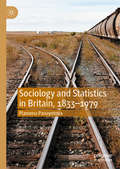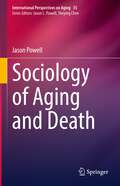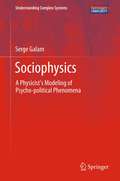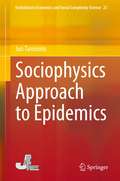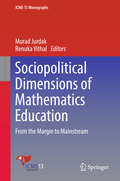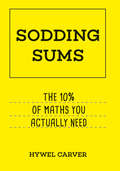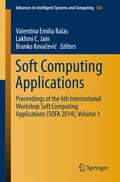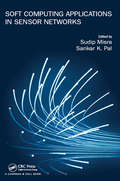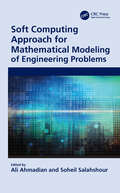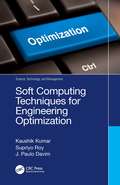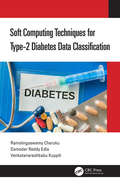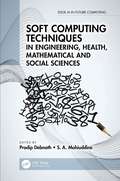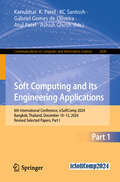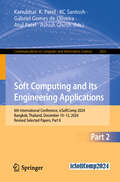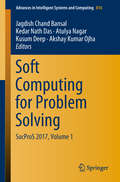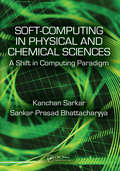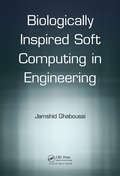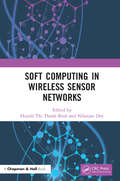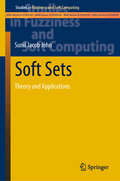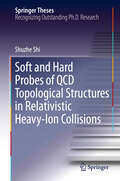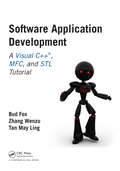- Table View
- List View
Sociology and Statistics in Britain, 1833–1979
by Plamena PanayotovaAt the beginning of the twentieth century, Britain stood at the forefront of science and statistics and had a long and respected tradition of social investigation and reform. But it still did not yet have a ‘science of society.’ When, in the early 1900s, a small band of enthusiasts got together to address this situation, the scene was set for a grand synthesis. No such synthesis ever took place and, instead, British sociology has followed a resolutely non-statistical path. Sociology and Statistics in Britain, 1833-1979 investigates how this curious situation came about and attempts to explain it from an historical perspective. It uncovers the prevalence of a deep and instinctive distrust within British sociology of the statistical methodology and mindset, resulting in a mix of quiet indifference and active hostility, which has persisted from its beginnings right up to the present day. While British sociology has thrived institutionally since the post-war expansion of higher education, this book asks whether or not it is poorer for having failed to recognise that statistics provides the foundations for the scientific study of society and for having missed opportunities to build upon those foundations. Ultimately, this important, revealing and timely book is about British sociology’s refusal to come to grips with a modern scientific way of thinking which no discipline that aspires to an effective study of society can afford to ignore.
Sociology as a Population Science
by John H. GoldthorpeJohn Goldthorpe is one of Britain's most eminent sociologists and a strong advocate of quantitative sociology. In this concise and accessible book, he provides a new rationale for recent developments in sociology which focus on establishing and explaining probabilistic regularities in human populations. Through these developments, Goldthorpe shows how sociology has become more securely placed within the 'probabilistic revolution' that has occurred over the last century in the natural and social sciences alike. The central arguments of the book are illustrated with examples from different areas of sociology, ranging from social stratification and the sociology of the family to the sociology of revolutions. He concludes by considering the implications of these arguments for the proper boundaries of sociology, for its relations with other disciplines, and for its public role.
Sociology of Aging and Death (International Perspectives on Aging #35)
by Jason PowellThis book presents a critical analysis and examination of the major theories and social issues in the social construction of aging and death. It is concerned with the impact of death and places how our experiences of death are transformed by the roles that truth and discourse about aging play in everyday life. A major element of the book is an examination of the way in which groups and individuals employ specific representations of mortality in order to construct meaning and purpose for life and death. To accentuate this, the book provides an investigation into the social construction of death practices across time and space. Special attention is given to the notion of death as a socially accomplished phenomenon grounded in a unique sociological introduction to the meaning of death throughout history to the present. The purpose of this book is to critically inform debates concerning the abstract and empirical features of death examined through the lens of sociological perspectives. This book explores the emergent biomedical dominance relating to ageing and death. An alternative is advocated which re-interprets ageing for Graduate schools. This innovative book explores the concept, history and theory of aging and its relationship to death. Traditionally, many books have focused on older people dying of 'natural causes', a biomedical explanatory framework. This book looks at alternative social theories and experiences with aging and relate to death in different countries, victims, crime, imprisonment and institutional care. Are these deaths avoidable? If so, what are the solutions the book addresses. This is one of the first books that re-interprets aging and its relationship of examples of death. It will be of essential reading for graduate students and researchers in understanding these different examples of aging and death across the globe.
Sociophysics
by Serge GalamDo humans behave much like atoms? Sociophysics, which uses tools and concepts from the physics of disordered matter to describe some aspects of social and political behavior, answers in the affirmative. But advocating the use of models from the physical sciences to understand human behavior could be perceived as tantamount to dismissing the existence of human free will and also enabling those seeking manipulative skills . This thought-provoking book argues it is just the contrary. Indeed, future developments and evaluation will either show sociophysics to be inadequate, thus supporting the hypothesis that people can primarily be considered to be free agents, or valid, thus opening the path to a radically different vision of society and personal responsibility. This book attempts to explain why and how humans behave much like atoms, at least in some aspects of their collective lives, and then proposes how this knowledge can serve as a unique key to a dramatic leap forwards in achieving more social freedom in the real world. At heart, sociophysics and this book are about better comprehending the richness and potential of our social interaction, and so distancing ourselves from inanimate atoms.
Sociophysics Approach to Epidemics (Evolutionary Economics and Social Complexity Science #23)
by Jun TanimotoThis book presents the fundamentals of evolutionary game theory and applies them to the analysis of epidemics, which is of paramount importance in the aftermath of the worldwide COVID-19 pandemic. The primary objective of this monograph is to deliver a powerful tool to model and analyze the spread of an infectious disease during a pandemic as well as the human decision dynamics. The book employs a variant of the “vaccination game,” in which a mathematical epidemiological model dovetails with evolutionary game theory. From a social physics standpoint, this book introduces an extended concept of the vaccination game starting from the fundamental issues and touching on the newest practical applications.The book first outlines the fundamental basis of evolutionary game theory, in which a two-player and two-strategy game, the so-called 2 × 2 game, and a multi-player game are concisely introduced, and the important issue of how social dilemmas are quantified is highlighted. Subsequently, the book discusses various recent applications of the extended concept of the vaccination game so as to quantitatively evaluate provisions other than vaccination, including practical intermediate protective measures such as mask-wearing, efficiency of quarantine compared with that of isolation policies for suppressing epidemics, efficiency of preemptive versus late vaccination, and optimal subsidy policies for vaccination.
Sociopolitical Dimensions of Mathematics Education
by Murad Jurdak Renuka VithalThis book documents and expands on the diverse social and political dimensions of mathematics education issues, concerns, perspectives, contexts, and approaches presented in Topic Study Group 34 of the 13th International Congress on Mathematical Education (ICME-13). The book also argues for and promotes the mainstreaming of the sociopolitical dimensions of mathematics education through an ongoing critique and inquiry into content, policies, practices and theories. Accordingly, the main theme throughout the book is captured and illuminated by bringing voices from the margin to the mainstream. In this respect it is both aspirational and a reality, as evidenced by the increasing references to the sociopolitical dimensions in other areas of mathematics education—for example, in several of the plenary presentations at the ICME-13. The authors have reflected on their ideas with a view to orienting and enhancing research in the sociopolitical dimensions of mathematics education that is grounded in current education systems within their specific sociocultural contexts.
Sodding Sums: The 10% of maths you actually need
by Hywel CarverMaths is a part of everyday life and there's no denying it. For anyone who has blocked distant memories of complicated algebraic formulae or incomprehensible trigonometry, numbers can strike fear at your very core. It is, however, an unavoidable part of life, so why struggle through without a clue? Hywel Carver is passionate about making maths approachable for everyone. In his go-to guide he introduces handy arithme`tricks' that help solve multiplication and division problems with rounding and approximations; explains fractions, percentages and ratios, how to convert between them and understand increases, decreases and multiplication; delves into all types of conversions - metric versus imperial, Celsius to Fahrenheit, as well as distances and speeds. These mathematical theories can then be applied to common conundrums, such as how mortgages and loans actually work, grasping an understanding of compound interest, the chances and probability of success in gambling games, and how to analyse statistics and data including causality, coincidence and correlation. Sodding Sums will subtract stress and divide difficulty so you no longer feel clueless when challenged by maths.
Sodding Sums: The 10% of maths you actually need
by Hywel CarverMaths is a part of everyday life and there's no denying it. For anyone who has blocked distant memories of complicated algebraic formulae or incomprehensible trigonometry, numbers can strike fear at your very core. It is, however, an unavoidable part of life, so why struggle through without a clue? Hywel Carver is passionate about making maths approachable for everyone. In his go-to guide he introduces handy arithme`tricks' that help solve multiplication and division problems with rounding and approximations; explains fractions, percentages and ratios, how to convert between them and understand increases, decreases and multiplication; delves into all types of conversions - metric versus imperial, Celsius to Fahrenheit, as well as distances and speeds. These mathematical theories can then be applied to common conundrums, such as how mortgages and loans actually work, grasping an understanding of compound interest, the chances and probability of success in gambling games, and how to analyse statistics and data including causality, coincidence and correlation. Sodding Sums will subtract stress and divide difficulty so you no longer feel clueless when challenged by maths.
Soft Computing Applications
by Lakhmi C. Jain Branko Kovačević Valentina Emilia BalasThese volumes constitute the Proceedings of the 6th International Workshop on Soft Computing Applications, or SOFA 2014, held on 24-26 July 2014 in Timisoara, Romania. This edition was organized by the University of Belgrade, Serbia in conjunction with Romanian Society of Control Engineering and Technical Informatics (SRAIT) - Arad Section, The General Association of Engineers in Romania - Arad Section, Institute of Computer Science, Iasi Branch of the Romanian Academy and IEEE Romanian Section. The Soft Computing concept was introduced by Lotfi Zadeh in 1991 and serves to highlight the emergence of computing methodologies in which the accent is on exploiting the tolerance for imprecision and uncertainty to achieve tractability, robustness and low solution cost. Soft computing facilitates the use of fuzzy logic, neurocomputing, evolutionary computing and probabilistic computing in combination, leading to the concept of hybrid intelligent systems. The combination of such intelligent systems tools and a large number of applications introduce a need for a synergy of scientific and technological disciplines in order to show the great potential of Soft Computing in all domains. The conference papers included in these proceedings, published post conference, were grouped into the following area of research: · Image, Text and Signal Processing Intelligent Transportation Modeling and Applications Biomedical Applications Neural Network and Applications Knowledge-Based Technologies for Web Applications, Cloud Computing, Security, Algorithms and Computer Networks Knowledge-Based Technologies Soft Computing Techniques for Time Series Analysis Soft Computing and Fuzzy Logic in Biometrics Fuzzy Applications Theory and Fuzzy Control Business Process Management Methods and Applications in Electrical Engineering The volumes provide useful information to professors, researchers and graduated students in area of soft computing techniques and applications, as they report new research work on challenging issues.
Soft Computing Applications in Sensor Networks
by Sudip Misra and Sankar K. PalThis book uses tutorials and new material to describe the basic concepts of soft-computing which potentially can be used in real-life sensor network applications. It is organized in a manner that exemplifies the use of an assortment of soft-computing applications for solving different problems in sensor networking. Written by worldwide experts, the chapters provide a balanced mixture of different problems concerning channel access, routing, coverage, localization, lifetime maximization and target tracking using emerging soft-computing applications.
Soft Computing Approach for Mathematical Modeling of Engineering Problems
by Ali AhmadianThis book describes different mathematical modeling and soft computing techniques used to solve practical engineering problems. It gives an overview of the current state of soft computing techniques and describes the advantages and disadvantages of soft computing compared to traditional hard computing techniques. Through examples and case studies the editors demonstrate and describe how problems with inherent uncertainty can be addressed and eventually solved through the aid of numerical models and methods. The chapters address several applications and examples in bioengineering science, drug delivery, solving inventory issues, Industry 4.0, augmented reality and weather forecasting. Other examples include solving fuzzy-shortest-path problems by introducing a new distance and ranking functions. Because, in practice, problems arise with uncertain data and most of them cannot be solved exactly and easily, the main objective is to develop models that deliver solutions with the aid of numerical methods. This is the reason behind investigating soft numerical computing in dynamic systems. Having this in mind, the authors and editors have considered error of approximation and have discussed several common types of errors and their propagations. Moreover, they have explained the numerical methods, along with convergence and consistence properties and characteristics, as the main objectives behind this book involve considering, discussing and proving related theorems within the setting of soft computing. This book examines dynamic models, and how time is fundamental to the structure of the model and data as well as the understanding of how a process unfolds • Discusses mathematical modeling with soft computing and the implementations of uncertain mathematical models • Examines how uncertain dynamic systems models include uncertain state, uncertain state space and uncertain state’s transition functions • Assists readers to become familiar with many soft numerical methods to simulate the solution function’s behaviorThis book is intended for system specialists who are interested in dynamic systems that operate at different time scales. The book can be used by engineering students, researchers and professionals in control and finite element fields as well as all engineering, applied mathematics, economics and computer science interested in dynamic and uncertain systems. Ali Ahmadian is a Senior Lecturer at the Institute of IR 4.0, The National University of Malaysia.Soheil Salahshour is an associate professor at Bahcesehir University.
Soft Computing Techniques for Engineering Optimization (Science, Technology, and Management)
by J. Paulo Davim Kaushik Kumar Supriyo RoyThis book covers the issues related to optimization of engineering and management problems using soft computing techniques with an industrial outlook. It covers a broad area related to real life complex decision making problems using a heuristics approach. It also explores a wide perspective and future directions in industrial engineering research on a global platform/scenario. The book highlights the concept of optimization, presents various soft computing techniques, offers sample problems, and discusses related software programs complete with illustrations. Features Explains the concept of optimization and relevance to soft computing techniques towards optimal solution in engineering and management Presents various soft computing techniques Offers problems and their optimization using various soft computing techniques Discusses related software programs, with illustrations Provides a step-by-step tutorial on how to handle relevant software for obtaining the optimal solution to various engineering problems
Soft Computing Techniques for Type-2 Diabetes Data Classification
by Damodar Reddy Edla Venkatanareshbabu Kuppili Ramalingaswamy CherukuDiabetes Mellitus (DM, commonly referred to as diabetes, is a metabolic disorder in which there are high blood sugar levels over a prolonged period. Lack of sufficient insulin causes presence of excess sugar levels in the blood. As a result the glucose levels in diabetic patients are more than normal ones. It has symptoms like frequent urination, increased hunger, increase thirst and high blood sugar. There are mainly three types of diabetes namely type-1, type-2 and gestational diabetes. Type-1 DM occurs due to immune system mistakenly attacks and destroys the beta-cells and Type-2 DM occurs due to insulin resistance. Gestational DM occurs in women during pregnancy due to insulin blocking by pregnancy harmones. Among these three types of DM, type-2 DM is more prevalence, and impacting so many millions of people across the world. Classification and predictive systems are actually reliable in the health care sector to explore hidden patterns in the patients data. These systems aid, medical professionals to enhance their diagnosis, prognosis along with remedy organizing techniques. The less percentage of improvement in classifier predictive accuracy is very important for medical diagnosis purposes where mistakes can cause a lot of damage to patient’s life. Hence, we need a more accurate classification system for prediction of type-2 DM. Although, most of the above classification algorithms are efficient, they failed to provide good accuracy with low computational cost. In this book, we proposed various classification algorithms using soft computing techniques like Neural Networks (NNs), Fuzzy Systems (FS) and Swarm Intelligence (SI). The experimental results demonstrate that these algorithms are able to produce high classification accuracy at less computational cost. The contributions presented in this book shall attempt to address the following objectives using soft computing approaches for identification of diabetes mellitus. Introuducing an optimized RBFN model called Opt-RBFN. Designing a cost effective rule miner called SM-RuleMiner for type-2 diabetes diagnosis. Generating more interpretable fuzzy rules for accurate diagnosis of type2 diabetes using RST-BatMiner. Developing accurate cascade ensemble frameworks called Diabetes-Network for type-2 diabetes diagnosis. Proposing a Multi-level ensemble framework called Dia-Net for improving the classification accuracy of type-2 diabetes diagnosis. Designing an Intelligent Diabetes Risk score Model called Intelli-DRM estimate the severity of Diabetes mellitus. This book serves as a reference book for scientific investigators who need to analyze disease data and/or numerical data, as well as researchers developing methodology in soft computing field. It may also be used as a textbook for a graduate and post graduate level course in machine learning or soft computing.
Soft Computing Techniques in Engineering, Health, Mathematical and Social Sciences (Edge AI in Future Computing)
by S. A. Mohiuddine Pradip DebnathSoft computing techniques are no longer limited to the arena of computer science. The discipline has an exponentially growing demand in other branches of science and engineering and even into health and social science. This book contains theory and applications of soft computing in engineering, health, and social and applied sciences. Different soft computing techniques such as artificial neural networks, fuzzy systems, evolutionary algorithms and hybrid systems are discussed. It also contains important chapters in machine learning and clustering. This book presents a survey of the existing knowledge and also the current state of art development through original new contributions from the researchers. This book may be used as a one-stop reference book for a broad range of readers worldwide interested in soft computing. In each chapter, the preliminaries have been presented first and then the advanced discussion takes place. Learners and researchers from a wide variety of backgrounds will find several useful tools and techniques to develop their soft computing skills. This book is meant for graduate students, faculty and researchers willing to expand their knowledge in any branch of soft computing. The readers of this book will require minimum prerequisites of undergraduate studies in computation and mathematics.
Soft Computing and Its Engineering Applications: 6th International Conference, icSoftComp 2024, Bangkok, Thailand, December 10–12, 2024, Revised Selected Papers, Part I (Communications in Computer and Information Science #2430)
by Ashish Ghosh Kanubhai K. Patel Atul Patel Gabriel Gomes de Oliveira Kc SantoshThe two-volume proceedings set CCIS 2430-2431 constitutes the revised selected papers of the 6th International Conference on Soft Computing and its Engineering Applications, icSoftComp 2024, held in Bangkok, Thailand, during December 10–12, 2024. The 58 full papers and 3 short papers included in this book were carefully reviewed and selected from 501 submissions. They were organized in topical sections as follows: Part I : Theory and Methods.Part II : Theory and Methods; Systems and Applications; Hybrid Techniques; Soft Computing for Smart World.
Soft Computing and Its Engineering Applications: 6th International Conference, icSoftComp 2024, Bangkok, Thailand, December 10–12, 2024, Revised Selected Papers, Part II (Communications in Computer and Information Science #2431)
by Ashish Ghosh Kanubhai K. Patel Atul Patel Gabriel Gomes de Oliveira Kc SantoshThe two-volume proceedings set CCIS 2430-2431 constitutes the revised selected papers of the 6th International Conference on Soft Computing and its Engineering Applications, icSoftComp 2024, held in Bangkok, Thailand, during December 10–12, 2024. The 58 full papers and 3 short papers included in this book were carefully reviewed and selected from 501 submissions. They were organized in topical sections as follows: Part I: Theory and Methods.Part II: Theory and Methods; Systems and Applications; Hybrid Techniques; Soft Computing for Smart World.
Soft Computing for Problem Solving: Socpros 2017, Volume 1 (Advances In Intelligent Systems and Computing #816)
by Kedar Nath Das Kusum Deep Jagdish Chand Bansal Atulya Nagar Akshay Kumar OjhaThis two-volume book presents outcomes of the 7th International Conference on Soft Computing for Problem Solving, SocProS 2017. This conference is a joint technical collaboration between the Soft Computing Research Society, Liverpool Hope University (UK), the Indian Institute of Technology Roorkee, the South Asian University New Delhi and the National Institute of Technology Silchar, and brings together researchers, engineers and practitioners to discuss thought-provoking developments and challenges in order to select potential future directions The book presents the latest advances and innovations in the interdisciplinary areas of soft computing, including original research papers in the areas including, but not limited to, algorithms (artificial immune systems, artificial neural networks, genetic algorithms, genetic programming, and particle swarm optimization) and applications (control systems, data mining and clustering, finance, weather forecasting, game theory, business and forecasting applications). It is a valuable resource for both young and experienced researchers dealing with complex and intricate real-world problems for which finding a solution by traditional methods is a difficult task.
Soft Computing in Chemical and Physical Sciences: A Shift in Computing Paradigm
by Kanchan Sarkar Sankar Prasad BhattacharyyaThis book can be regarded as 'Soft computing for physicists and chemists self-taught'. It prepares the readers with a solid background of soft computing and how to adapt soft computing techniques to problem solving in physical and chemical research. Soft computing methods have been little explored by researchers in physical and chemical sciences primarily because of the absence of books that bridge the gap between the traditional computing paradigm pursued by researchers in science and the new soft computing paradigm that has emerged in computer science. This book is the interface between these primary sources and researchers in physics and chemistry.
Soft Computing in Engineering
by Jamshid GhaboussiSoft computing methods such as neural networks and genetic algorithms draw on the problem solving strategies of the natural world which differ fundamentally from the mathematically-based computing methods normally used in engineering. Human brains are highly effective computers with capabilities far beyond those of the most sophisticated electronic computers. The 'soft computing‘ methods they use can solve very difficult inverse problems based on reduction in disorder. This book outlines these methods and applies them to a range of difficult engineering problems, including applications in computational mechanics, earthquake engineering, and engineering design. Most of these are difficult inverse problems – especially in engineering design – and are treated in depth.
Soft Computing in Wireless Sensor Networks
by Nilanjan Dey Huynh Thi Thanh BinhThis book focuses on the suitable methods to solve optimization problems in wireless network system utilizing digital sensors like Wireless Sensor Network. This kind of system has been emerging as the cornerstone technology for all new smart devices and its direct application in many fields in life.
Soft Sets: Theory and Applications (Studies in Fuzziness and Soft Computing #400)
by Sunil Jacob JohnThis book offers a self-contained guide to the theory and main applications of soft sets. It introduces readers to the basic concepts, the algebraic and topological structures, as well as hybrid structures, such as fuzzy soft sets and intuitionistic fuzzy sets. The last part of the book explores a range of interesting applications in the fields of decision-making, pattern recognition, and data science. All in all, the book provides graduate students and researchers in mathematics and various applied science fields with a comprehensive and timely reference guide to soft sets.
Soft and Hard Probes of QCD Topological Structures in Relativistic Heavy-Ion Collisions (Springer Theses)
by Shuzhe ShiThis thesis makes significant advances in the quantitative understanding of two intrinsically linked yet technically very different phenomena in quantum chromodynamics (QCD). Firstly, the thesis investigates the soft probe of strong interaction topological fluctuations in the quark-gluon plasma (QGP) which is made possible via the anomalous chiral transport effects induced by such fluctuations. Here, the author makes contributions towards establishing the first comprehensive tool for quantitative prediction of the chiral magnetic effect in the QGP that is produced in heavy ion collision experiments. Secondly, the thesis deals with the hard probe of strongly coupled QGP created in heavy-ion collisions. In particular, this study addresses the basic question related to the nonperturbative color structure in the QGP via jet energy loss observables. The author further develops the CUJET computational model for jet quenching and uses it to analyze the topological degrees of freedom in quark-gluon plasma. The contributions this thesis makes towards these highly-challenging problems have already generated widespread impacts in the field of quark-gluon plasma and high-energy nuclear collisions.
Software Adaptation in an Open Environment: A Software Architecture Perspective
by Yu Zhou Taolue ChenThe book is about a very active research field in software engineering. In modern society, the fact of the world's high reliance on software requires the system's robustness, i.e., continual availability and satisfactory service quality. This requirement gives rise to the popularity of the research on the self-adaptive software in open environment. There are some academic conferences dedicated to this field. But there is a lack of monographs about the topic. We believe such need is unmet in marketplace. By publishing the book, it can help bridge the gap and bring benefits to readers thereof. Key Features: The topic is well-motivated, interesting and actively studied worldwide The research represents as the state-of-the-art in the field The technical part of the book is rigidly evaluated The theoretical part of the book is sound and proved The organization and presentation of the book will be double-checked by professional scholars
Software Application Development: A Visual C++, MFC, and STL Tutorial (Chapman & Hall/CRC Computer and Information Science Series)
by Bud Fox Ph.D. Zhang Wenzu Ph.D. Tan May Ling M.Sc.Software Application Development: A Visual C++, MFC, and STL Tutorial provides a detailed account of the software development process using Visual C++, MFC, and STL. It covers everything from the design to the implementation of all software modules, resulting in a demonstration application prototype which may be used to efficiently represent mathem
Software Design: Creating Solutions for Ill-Structured Problems (Chapman & Hall/CRC Innovations in Software Engineering and Software Development Series)
by David BudgenSoftware Design: Creating Solutions for Ill-Structured Problems, Third Edition provides a balanced view of the many and varied software design practices used by practitioners. The book provides a general overview of software design within the context of software development and as a means of addressing ill-structured problems. The third edition has been expanded and reorganised to focus on the structure and process aspects of software design, including architectural issues, as well as design notations and models. It also describes a variety of different ways of creating design solutions such as plan-driven development, agile approaches, patterns, product lines, and other forms. Features •Includes an overview and review of representation forms used for modelling design solutions •Provides a concise review of design practices and how these relate to ideas about software architecture •Uses an evidence-informed basis for discussing design concepts and when their use is appropriate This book is suitable for undergraduate and graduate students taking courses on software engineering and software design, as well as for software engineers. Author David Budgen is a professor emeritus of software engineering at Durham University. His research interests include evidence-based software engineering (EBSE), software design, and healthcare informatics.
